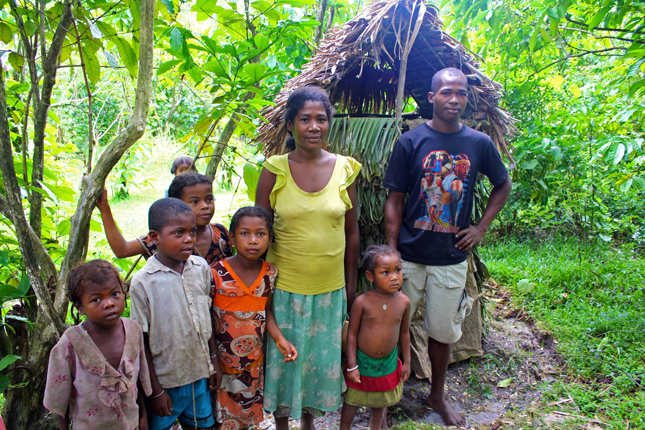-
New Network Links Madagascar’s Environment and Health Sectors
October 7, 2014 By Laura Robson
As the international community seeks to articulate a collective vision for sustainable development following the Millennium Development Goals, a vibrant new network has emerged in Madagascar to advance integrated population, health and environment (PHE) initiatives across this island nation.
A global biodiversity hotspot facing interconnected challenges of environmental degradation, climate change vulnerability, food insecurity, and poor access to health services, Madagascar sits at the intersection of many issues. As a result, it’s been the cradle of many innovative sustainable development efforts over the years.
Learning From a Rich History
Today, the nascent Madagascar PHE Network launches a report highlighting the country’s rich history of integrated conservation and development initiatives, stretching back over 25 years.
The island has been the cradle of many innovative sustainable development efforts
These efforts started with projects linking community-based natural resource management and voluntary family planning services around protected areas during the 1990s. Combining interventions from the environment and health sectors was, and still is, unusual. But this holistic approach made sense to communities and practitioners who found that integrated responses could be more effective at improving human and ecosystem health than addressing either issue in isolation – something that we at Blue Ventures still find is true today.

Larger-scale PHE projects followed in the early-mid 2000s, when the JSI Research and Training Institute Inc. pioneered a “Champion Community” approach to engage villagers in setting targets and undertaking activities to improve their health and protect the environment.
Also during this period, USAID’s Environmental Health Project supported research to assess the effectiveness of PHE programs versus single-sector interventions. A platform called Voahary Salama was established to coordinate this study and PHE activities nationwide; it later transitioned to serve as a more general representative of civil society in various forums, and became a locus for channeling funds to Malagasy members implementing health programs in biodiversity hotspots.
Large international environmental organizations including Conservation International, the World Wildlife Fund, and the Wildlife Conservation Society implemented PHE projects in Madagascar during the mid-to-late 2000s, together with a variety of health agencies.
A more recent partnership forged between the Duke Lemur Center and Marie Stopes Madagascar demonstrates how easily such skills-sharing collaborations can be established, particularly where the work of health and conservation organizations already overlap.
Seizing the Moment
Building on this momentum for PHE, as well as renewed interest from Madagascar’s newly elected government and numerous international funders, Blue Ventures along with Voahary Salama convened a meeting in the capital city of Antananarivo at the end of July.
The meeting brought together practitioners, donors, and policymakers representing 35 different health and environment organizations from around the country.
Participants were able to share their experiences with one another, facilitating more collaboration. Importantly, the meeting also led to a strong consensus for the creation of a national PHE network, focused on exchanging learning and promoting broader uptake of this integrated approach to sustainable development. This led to the creation of the Madagascar PHE Network.
There is a rich history of integrated community development in Madagascar, but most exciting may be the future
Tiana Rahagalala of the Wildlife Conservation Society, currently preparing to implement a PHE program in northeastern Madagascar, is one of many participants who benefited from this initial meeting. “I’m counting a lot on the network because I’ve found that it’s a very quick way of sharing information and above all learning from the achievements of others,” she said.
Network members have since formed a discussion group to continue conversations online and further identify opportunities for building partnerships. Their recently launched website features a resource library and a series of frequently asked questions relating specifically to Madagascar, as well as details of member activities and intervention zones.
The creation of the Madagascar PHE Network has been thrilling. Witnessing the commitment and enthusiasm for this holistic and community-based approach gives us reason to believe that this is just the beginning of its renewal and expansion across Madagascar.
“My hopes and expectations of the Madagascar PHE Network is that it grows to include a large number of partners who can share lessons learned and problems overcome in years to come,” said Erik Patel, director of the Duke Lemur Center’s SAVA Conservation Project.
As policymakers consider sustainable development goals on a global scale, they’d do well to pay attention to this island nation. There is a rich history of integrated community development in Madagascar, but most exciting may be the future.
Download “The History of PHE in Madagascar” report here.
Caroline Savitzky of Blue Ventures will speak about the Madagascar PHE Network at the Wilson Center on October 14.
Laura Robson is the community health program coordinator for Blue Ventures. Follow her (@salamasoa) and Blue Ventures (@blueventures) on Twitter for updates.
Sources: Blue Ventures, JSI Research and Training Institute, Inc., PHE Madagascar Network, USAID.
Photo Credit: Used with permission courtesy of Jonathan Coxall and Laura Robson. Video: Blue Ventures.
Topics: Africa, biodiversity, climate change, community-based, conservation, cooperation, development, environment, environmental health, family planning, featured, food security, global health, Guest Contributor, MDGs, natural resources, oceans, PHE, population, poverty, protected areas, SDGs, USAID, video
 A Publication of the Stimson Center.
A Publication of the Stimson Center.




